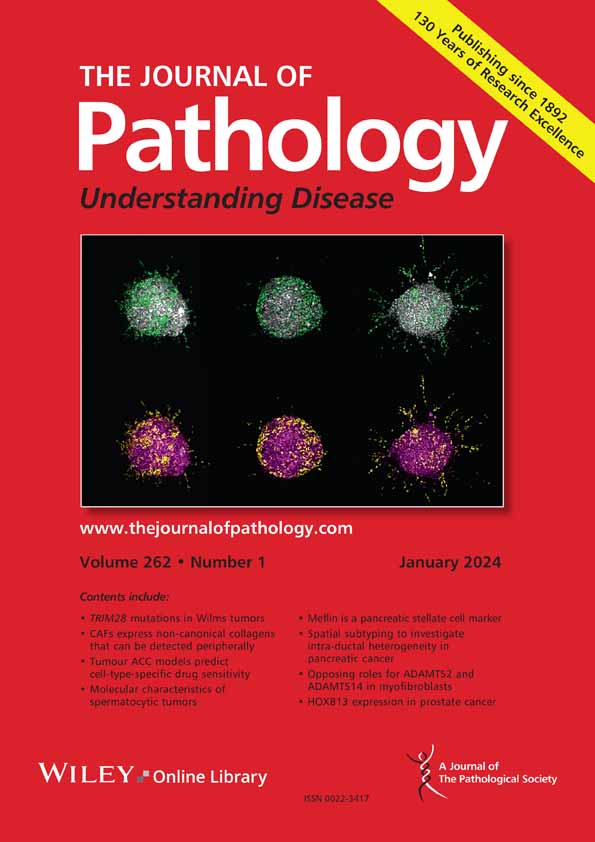下载PDF
{"title":"Elevated NPM1 and FBL expression correlates with prostate cancer aggressiveness and progression","authors":"Sarina Saffarian, Ziwei Cai, Jordan Lam, Htoo Zarni Oo, Syam Somasekharan","doi":"10.1002/path.6447","DOIUrl":null,"url":null,"abstract":"<p>The nucleolus is a membrane-less body present in the nucleus of the cell. The nucleolus is mainly involved in ribosomal RNA (rRNA) transcription and ribosome biogenesis for protein translation. During cancer formation, nucleolar morphology is altered, and many nucleolar proteins are expressed at a higher level, leading to enhanced ribosome biogenesis and protein translation, which supports cancer aggressiveness, proliferation, migration, and invasion. In this study, we investigated the association of two nucleolar proteins, nucleophosmin (NPM1), and fibrillarin (FBL), with prostate cancer (PCa) aggressiveness and progression. We investigated their cellular localization and expression in different PCa patient tissue specimens and their role in regulating proliferation, migration, invasion, and nucleolar morphology. Our results indicate that NPM1 and FBL are present in the nucleolus of both PCa and noncancerous prostatic cells. The expression of NPM1 and FBL was enhanced in aggressive castration-resistant PCa (CRPC) and neuro-endocrine PCa (NEPC) patient specimens compared to hormone-naïve PCa (HNPC) patient specimens. The expression of NPM1 was enhanced in high-Gleason score PCa compared to low-Gleason score PCa. Silencing of NPM1 and FBL significantly reduced the proliferation, migration, and invasion of PCa cells without affecting noncancerous prostatic cells. Silencing of NPM1 and FBL also changed the morphology of nucleoli in both PCa and noncancerous prostatic cells, where NPM1 silencing fragmented the nucleoli and FBL silencing condensed the nucleoli. Our results suggest that NPM1 and FBL expression correlates with PCa aggressiveness and PCa cells may exhibit a unique dependence on NPM1 or FBL for PCa progression. © 2025 The Author(s). <i>The Journal of Pathology</i> published by John Wiley & Sons Ltd on behalf of The Pathological Society of Great Britain and Ireland.</p>","PeriodicalId":232,"journal":{"name":"The Journal of Pathology","volume":"267 1","pages":"56-68"},"PeriodicalIF":5.2000,"publicationDate":"2025-07-24","publicationTypes":"Journal Article","fieldsOfStudy":null,"isOpenAccess":false,"openAccessPdf":"https://pathsocjournals.onlinelibrary.wiley.com/doi/epdf/10.1002/path.6447","citationCount":"0","resultStr":null,"platform":"Semanticscholar","paperid":null,"PeriodicalName":"The Journal of Pathology","FirstCategoryId":"3","ListUrlMain":"https://pathsocjournals.onlinelibrary.wiley.com/doi/10.1002/path.6447","RegionNum":2,"RegionCategory":"医学","ArticlePicture":[],"TitleCN":null,"AbstractTextCN":null,"PMCID":null,"EPubDate":"","PubModel":"","JCR":"Q1","JCRName":"ONCOLOGY","Score":null,"Total":0}
引用次数: 0
引用
批量引用
Abstract
The nucleolus is a membrane-less body present in the nucleus of the cell. The nucleolus is mainly involved in ribosomal RNA (rRNA) transcription and ribosome biogenesis for protein translation. During cancer formation, nucleolar morphology is altered, and many nucleolar proteins are expressed at a higher level, leading to enhanced ribosome biogenesis and protein translation, which supports cancer aggressiveness, proliferation, migration, and invasion. In this study, we investigated the association of two nucleolar proteins, nucleophosmin (NPM1), and fibrillarin (FBL), with prostate cancer (PCa) aggressiveness and progression. We investigated their cellular localization and expression in different PCa patient tissue specimens and their role in regulating proliferation, migration, invasion, and nucleolar morphology. Our results indicate that NPM1 and FBL are present in the nucleolus of both PCa and noncancerous prostatic cells. The expression of NPM1 and FBL was enhanced in aggressive castration-resistant PCa (CRPC) and neuro-endocrine PCa (NEPC) patient specimens compared to hormone-naïve PCa (HNPC) patient specimens. The expression of NPM1 was enhanced in high-Gleason score PCa compared to low-Gleason score PCa. Silencing of NPM1 and FBL significantly reduced the proliferation, migration, and invasion of PCa cells without affecting noncancerous prostatic cells. Silencing of NPM1 and FBL also changed the morphology of nucleoli in both PCa and noncancerous prostatic cells, where NPM1 silencing fragmented the nucleoli and FBL silencing condensed the nucleoli. Our results suggest that NPM1 and FBL expression correlates with PCa aggressiveness and PCa cells may exhibit a unique dependence on NPM1 or FBL for PCa progression. © 2025 The Author(s). The Journal of Pathology published by John Wiley & Sons Ltd on behalf of The Pathological Society of Great Britain and Ireland.
NPM1和FBL表达升高与前列腺癌的侵袭性和进展相关。
核仁是存在于细胞核中的无膜体。核仁主要参与核糖体RNA (rRNA)转录和蛋白质翻译的核糖体生物发生。在癌症形成过程中,核仁形态发生改变,许多核仁蛋白在更高水平上表达,导致核糖体生物发生和蛋白质翻译增强,从而支持癌症的侵袭性、增殖、迁移和侵袭。在这项研究中,我们研究了两种核仁蛋白,核磷蛋白(NPM1)和纤维蛋白(FBL)与前列腺癌(PCa)侵袭性和进展的关系。我们研究了它们在不同前列腺癌患者组织标本中的细胞定位和表达,以及它们在调节增殖、迁移、侵袭和核仁形态中的作用。我们的研究结果表明NPM1和FBL存在于前列腺癌和非癌性前列腺细胞的核仁中。与hormone-naïve PCa (HNPC)患者相比,侵袭性去势抵抗PCa (CRPC)和神经内分泌PCa (NEPC)患者标本中NPM1和FBL的表达增强。与低gleason评分的PCa相比,高gleason评分的PCa中NPM1的表达增强。NPM1和FBL的沉默显著降低了前列腺癌细胞的增殖、迁移和侵袭,而不影响非癌性前列腺细胞。NPM1和FBL的沉默也改变了前列腺癌和非癌性前列腺细胞的核仁形态,其中NPM1沉默使核仁碎片化,FBL沉默使核仁凝聚。我们的研究结果表明,NPM1和FBL的表达与PCa的侵袭性相关,并且PCa细胞可能对NPM1或FBL表现出独特的依赖。©2025作者。《病理学杂志》由John Wiley & Sons Ltd代表大不列颠和爱尔兰病理学会出版。
本文章由计算机程序翻译,如有差异,请以英文原文为准。






 求助内容:
求助内容: 应助结果提醒方式:
应助结果提醒方式:


